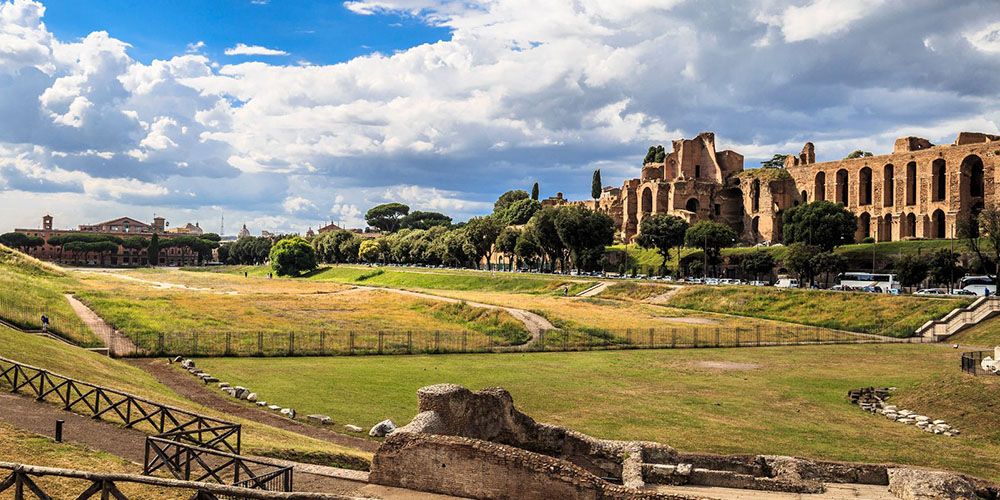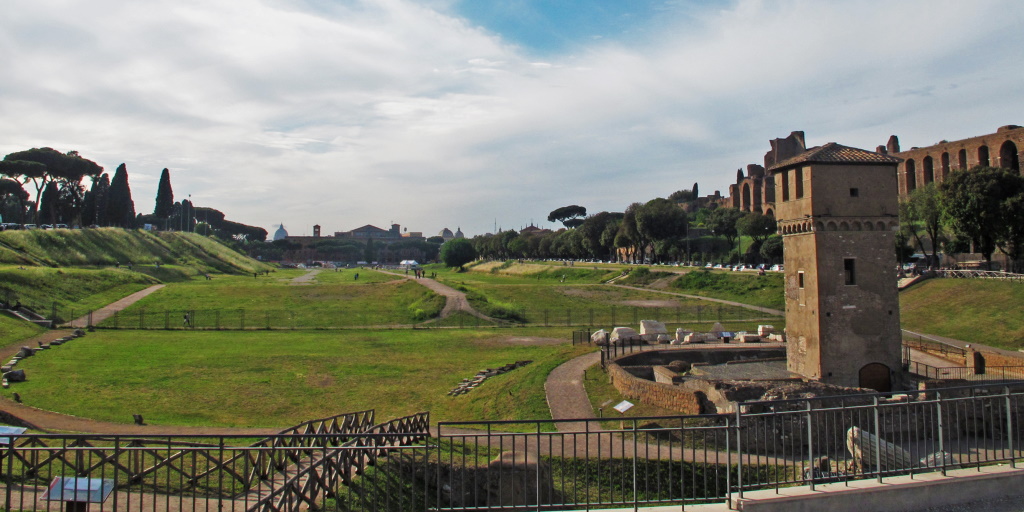
Rome Taxi Airport – Private Transfer From Rome Airport in a spacious and elegant vehicle for up to eight passengers
Curious about what Circus Maximus is and how to visit it? Everything you need to know about exploring the historic Circus Maximus in Rome.
The Circus Maximus is an ancient stadium dedicated to horse racing and public shows related to Roman religious festivals, the “Ludi Romani”. Even today it is the largest stadium ever built by man.
Built by Gaius Julius Caesar in the 2nd century BC
What to see: Archaeological area of the Circus Maximus, Moletta tower
Opening hours: Every day, 24 hours a day (details and limitations in the article)
The largest stadium in history: the Circus Maximus
Structure of the Circus Maximus
The Circus Maximus has been configured, since its origins, as a place of aggregation and entertainment and, during the Augustan principality and in the years immediately following, its spaces were well defined and circumscribed.
The dimensions of the Circus Maximus are remarkable: it is no coincidence that it is one of the largest structures for shows in antiquity, with its 600 meters in length and 140 in width.
Rome Taxi Airport – The main parts of the Circus Maximus are:

The cavea: each social class had its own seat
The cavea, or the steps on which the spectators sat, occupied an area of about 38,000 square meters, developed on three levels (the lower one with stone seats and the upper ones in wood), and was divided into four sectors, based on the social hierarchy. In fact, they are distinguished, from bottom to top: ima cavea, media cavea, summa cavea and porticus in summa cavea. The best seats were obviously assigned to the highest social classes (knights and senators), while the others were for the use of the plebs. Currently, numerous fragments of travertine steps are visible, about 50 cm deep and 28 cm high, with the front side decorated with a strip in the upper part.
As Patrizia Arena recounts (The Circus Maximus as a microcosm of the empire through the distribution of seats) “already in 194 BC or 191 BC the censors ordered the curule aediles to separate the seats for the senators from those for the people, starting the long series of laws on seating in the ludi in Rome”. These laws would then lead, in the imperial era, to the permanent assignment of some seats assigned to the highest classes, to the priestly castes and to the members of the imperial family.
These seats were delimited by barriers, of which fragments remain in Luni marble decorated with dolphins. It is curious to remember how even the deceased princes of the Domus Augusta, during the principality of Augustus and Tiberius, had a sella (stone seat) reserved for them in the Circus and in the theaters, precisely in the place they had occupied when they were still alive.
The capacity of the cavea follows the evolution of the Circus Maximus itself: under the principality of Trajan, who rebuilt the site almost entirely, a theoretical number of seats between 200,000 and 225,000 is hypothesized, while the Regional Catalogues in the late ancient age report the figure – perhaps too happy – of 385,000 or 485,000 seats.
Carceres

The carceres were nothing other than the gates from which the chariots departed, and constituted the limit of the Circus Maximus on the side of the Tiber, on the opposite side of the Arch of Titus. They were placed on a slightly oblique line, a bit like modern starting blocks in athletics, to give all competitors the same opportunities, and a complex mechanism allowed them to open simultaneously.
The first wooden carceres were built in 329 BC, which were then followed by subsequent restoration and reconstruction interventions. Claudius is responsible for the construction of stable and permanent carceres in marble, which will definitively constitute the western limit of the Circus Maximus.
As already underlined, the Circus Maximus is deeply linked to the cultic and sacred aspects of Roman life, and not only to games and contests as ends in themselves. For this reason, it is imbued, even in its most functional structures, with a profound symbolism, and this also concerns the carceres. There were in fact twelve of them, like the signs of the zodiac and like the months of the year.
The spina
The spina, or the rectangular platform placed at the center of the Circus Maximus, was delimited by two markers (metae), and was richly decorated with statues, signa and shrines of the main deities connected to the games. Starting from the second half of the 2nd century, it is also cited with the term Euripus, which refers to pools, fountains and basins of water that further decorated this scenographic and symbolic decorative apparatus. Not much remains of the decoration of the spina, due to a systematic stripping of the structures that began both in the post-ancient and medieval ages.
The exceptions are a fragment of a relief with a shipwreck scene, a fragment of a sculpture depicting a crocodile and several other decorated fragments. A different fate from that of the other decorative elements is that of the two Egyptian obelisks. The first was placed by Augustus in 10 BC at the centre of the spina, while the second was erected by Constantius II in 357.
However, they no longer maintain their original position. In fact, they were recovered in 1587 on the orders of Sixtus V, transported and reassembled in Piazza S. Giovanni in Laterano and in Piazza del Popolo. The bases and the stalls in travertine and red granite were lost in the excavations.
Hemicycle

The eastern hemicycle of the Circus Maximus is partially preserved and can currently be visited, and allows one to get an idea of how the Circus Maximus was truly a microcosm functional to the life of the city. This too, like the entire site, has undergone modifications and expansions over time, changes still visible in the different materials and construction techniques.
In general, however, two different types of rooms can be identified on the ground floor: those for passage and those intended for shops. The first type includes rooms and corridors with stairs that led to the upper floors of the cavea (now lost due to the fragility of these structures, probably made of wood) or to the lower ones, while the second type was reserved for the tabernae and all the other activities that were a corollary to the activities of the Circus.
Horse racing betting centers, food shops, warehouses, inns and even brothels: all these buildings occupied the eastern hemicycle of the Circus, offering spectators a truly immersive experience of leisure and entertainment.
The facade of the hemicycle was decorated with thin peperino pillars, while the supports of the steps were made of brick walls. After the reconstruction of the Trajan era, to which the structures visible today date back, additional support walls were built in a grid on foundations in reinforced cable and hydraulic structures made from recycled material.
The Circus Maximus today
It still performs this function uninterruptedly today: it is one of the favorite Roman locations for shows, concerts and events of global importance. The secret of this success is linked both to its excellent geographical position, between the Palatine and the Aventine, in the Murcia Valley, and to its enormous capacity.
Today, the area of the Circus Maximus track can be enjoyed by anyone who lives in the capital or organizes a visit to Rome: in the large green area it is possible to jog, walk with dogs or simply sunbathe surrounded by the remains of the ancient structure.
This suggestive setting between the Palatine and the Aventine also serves as a backdrop to numerous events, including shows, concerts and sporting events, which bring the Circus Maximus back to its ancient function as an area of social and political aggregation, a true microcosm.
The tour is well organized, thanks to the restoration work completed in 2016, and allows you to visit the galleries that led to the steps of the cavea and the shops adjacent to the road, as well as admire the entire archaeological area from a specially built panoramic terrace. Particularly suggestive is also the Circo Maximo Experience, a tour lasting about 40 minutes that takes place with the help of augmented and virtual reality technology and that allows you to visit – virtually – the Circus Maximus in all its ancient splendor during the various phases of construction.
********************************************************************************************************
BOOKING – ROME TAXI AIRPORT
Step 1: Request a quote
Submit your service request by filling out the quote form below or via whatsapp
Step 2: Get the quote
Once the request has been submitted, you will receive our quote in a few minutes or a few hours.
Step 3: Confirmation
If you are interested in the quote you receive, you can confirm it by simply replying to the email or message.
Step 4: Completing the operation
Wait for our confirmation of booking completion, service summary, details, and driver contact.
*********************************************************************************************
Find exciting holiday ideas for this years holiday in Italy
Travel Tips for Rome
Rome Italy Tours – Beautiful Places Tips and Advice
Vatican Tours – Visit St. Peter’s Basilica and the Sistine Chapel









